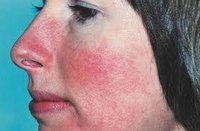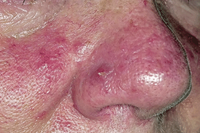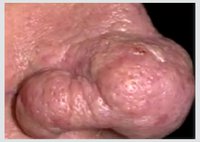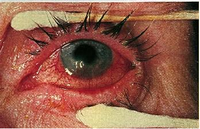Rosacea Treatments
Improve the symptoms of rosacea with the help of our medical expert team
- Skin health and complexion treatments
- Prescription treatments to reduce inflammatory redness
- Treatment administered by medical experts

If you are suffering with Rosacea then Outline Clinic in Droitwich are here to help. Call the experts and visit our Droitwich, Worcestershire Rosacea Clinic.
What Is Rosacea?
Rosacea is a chronic (long term), inflammatory cutaneous disease of the skin, where there is excessive redness and often “flushing” of the face.
It affects up to 10% of the population - both men and women, often after the age of 30, and typically fair skinned people. Rosacea has some or all of the following symptoms:
- Flushing and redness of the cheeks
- Papules and spots
- Visible broken capillaries (telangiectasia)
- Burning and stinging sensation
Types Of Rosacea
Rosacea can be categorized into 4 main groups or types:

Erythemato Telangiectatic Rosacea (ETR)
This is the classic, flushing type that affects around 75% of sufferers. Typically the redness is on the cheeks and doesn’t affect around the eyes. Skin is sensitive and often dry and flaky. An itching or burning sensation is not uncommon. Visible broken veins and capillaries can appear over the affected areas.

Papulopustular Rosacea
Sufferers have redness and small spots or pustules that come and go. This type of rosacea affects 25% of sufferers. Usually flushing does not occur and the burning and stinging sensations associated with ETR are rare. This type of rosacea can be differentiated from true acne, because comedones (blackheads or whiteheads) are not present in papulopustular acne, whereas they are in acne.

Phymatous Rosacea
This type of rosacea presents with thickening of the skin. Sometimes this can be so severe that facial features (typically the nose – rhinophyma) can become distorted. This can cause distress for many patients, because rhinophyma is often wrongly mistaken for a “drinker’s nose”.

Ocular Rosacea
Symptoms include watery, bloodshot eyes that feel gritty, dry and irritated. Occasionally eyes may become prone to infection, and loss of vision can occur.
Reducing Rosacea Symptoms
The exact cause of rosacea is unknown. However, usually there are several “triggers” that a sufferer can identify and these can include:
- Sunlight
- Stress
- Hot Weather
- Cold Weather
- Exposure to wind
- Alcohol
- Strenuous Exercise
- Hot Baths
- Spicy Foods
- Humidity
- Caffeine
Avoiding these triggers can help to reduce your symptoms, but it is not always practical to avoid every trigger.
Laser treatment can be effective at removing the visible broken veins. Usually 1-3 treatments are required. However this does not remove the underlying flushing and redness.
Metronidazole gel or oral antibiotics can be prescribed to reduce pustular spots.
Rosacea Treatment
A new topical cream, Mirvaso, can be helpful to reduce flushing, redness and burning. Mirvaso contains Brimonodine, which constricts small blood vessels, thus reducing the appearance of redness.
It is a gel that can be prescribed from our Droitwich Rosacea Clinic, and is applied to the affected areas once a day. Whilst it is not a cure for rosacea, the effects of Mirvaso can last up to 12 hours. Mirvaso may be applied every day and works fast – in as little as 30 minutes.
Mirvaso may be used alongside other treatments for rosacea such as laser, or antibiotic therapy.
Our prescribing nurse, Mary White, has over 2 decades experience with lasers and dermatology conditions and will be able assess the problem and suggest the best and most appropriate treatment plan for you. This may be a combination of the above treatments.
